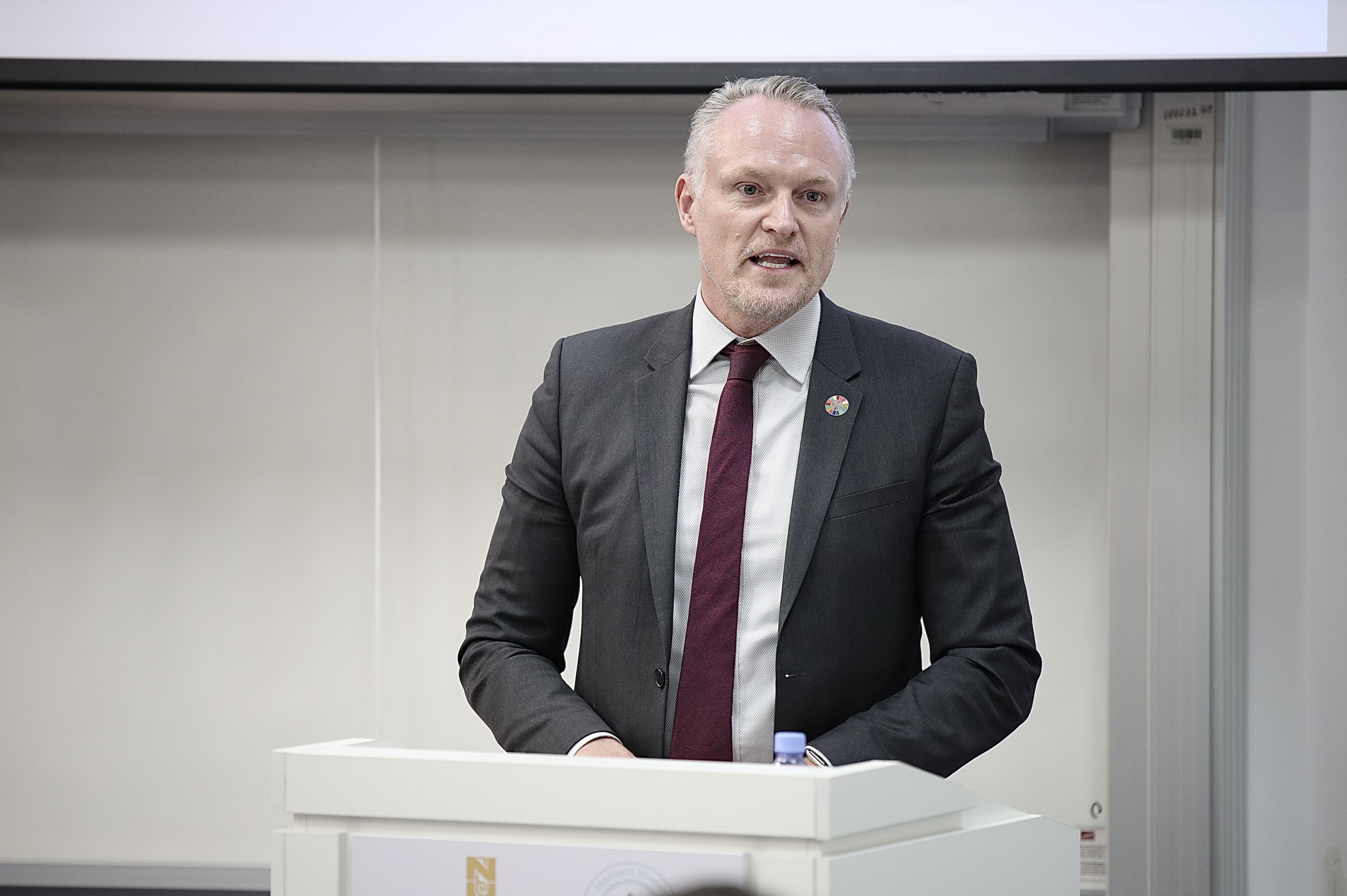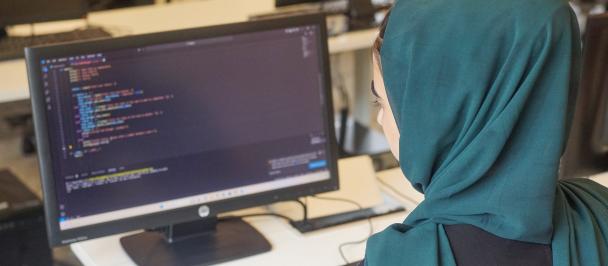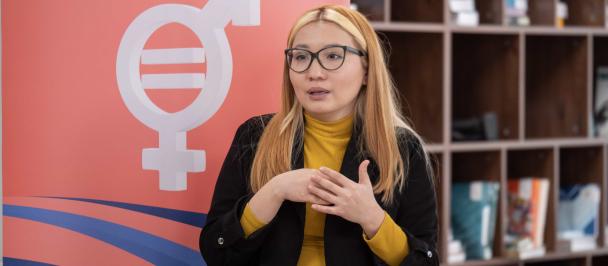Speech of UNDP Deputy Regional Bureau Director and Deputy Assistant Administrator Nick Rene Hartmann
January 24, 2024

Ladies and gentlemen, esteemed guests,
As we gather today to discuss the pivotal role of women in science, technology, engineering, and mathematics (STEM), I extend my heartfelt greetings to you.
Soon, we will be celebrating the International Day of Women and Girls in Science, held annually on February 11th. The day holds profound importance as it serves to recognize and promote the achievements of women and girls in STEM fields, acknowledging the crucial contributions they make to the advancement of knowledge and innovation.
The International Day of Women and Girls in Science serves as a powerful reminder of the challenges and barriers that women have historically faced in pursuing careers in science. By designating this day, the international community commits to closing the gender gap in STEM fields, extending beyond just achieving gender equality; but also shaping our future - a future that thrives on innovation and inclusion. This date was chosen to honor the birthday of Marie Curie, a trailblazing scientist and the first woman to win a Nobel Prize. Her groundbreaking work in physics and chemistry paved the way for countless women in science, serving as an inspiration for generations to come. Of the 710 Nobel Prizes awarded in Physics, Chemistry, and Physiology or Medicine between 1901 and 2023, only 29 have been awarded to women.
This profound gender imbalance highlights the persistent challenges that women face in gaining recognition for their groundbreaking contributions to STEM fields. Celebrating the International Day of Women and Girls in Science on Marie Curie's birthday symbolizes the resilience, tenacity, and brilliance of women who have overcome obstacles to contribute significantly to the scientific community.
Recent data here from Kazakhstan reveals a stark reality: only 30% of STEM graduates are women, underscoring a significant underrepresentation in comparison to their male counterparts. This mirrors a global trend where women continue to face disproportionate challenges in STEM fields, at large due to gender bias and stereotypes.
Comparatively, nations like Sweden and Finland have made commendable strides. These countries boast nearly equal representation of men and women in STEM programs, owing to inclusive educational policies that actively encourage girls to pursue STEM subjects from a young age. For instance, Sweden's focus on early exposure to STEM, coupled with targeted mentorship programs, has resulted in a more balanced representation within STEM disciplines.
Role models play a pivotal role in shaping aspirations and go against traditional roles attributed to women, pushing development backwards. In Kazakhstan, while there are notable women STEM professionals, their poor visibility hampers progress toward gender equality.
Each year, closer to my home, Denmark, a partnership between the L’Oréal Foundation in Denmark and the national UNESCO Commission, together with the Danish Royal Academy of Sciences, announces a “For Women in Science” programme call to recognize and promote talented Danish early stage women researchers to pursue their research projects within the natural sciences.
Transitioning from education to the workplace, the issue of the ‘glass ceiling’ becomes apparent. Globally, only 28% of researchers are women. This of course has nothing to do with their capabilities in this role. Professor Clara Goldin from Harvard won Nobel Prize just last year proving this phenomenon based on historical data spanning for centuries – women pay a high price due to demands of balancing career and family right after the birth of the first child. Addressing the challenges women face in their careers in relation to their personal choices, including after childbirth, is paramount. For example, Iceland's implementation of progressive parental leave policies serves as an exemplary model. By offering flexible work arrangements and shared parental responsibilities, Iceland has minimized the impact on women's career trajectories.
Our examination of gender disparities extends beyond academia to the broader realm of popular culture. The representation of women in STEM in the film industry and literature remains far from proportional. Recent studies indicate that women are significantly underrepresented in STEM-related roles in both Hollywood films and literary works.
According to the Geena Davis Institute on Gender in Media studies a sizeable number of STEM characters (42.9%), almost half, were shown as sacrificing their personal life to work in STEM fields. It is presented as being demanding and requiring sacrifice. Given the strong family values and stereotypes in many societies in which becoming a mother is perceived as both a desirable and necessary role of every woman – these messages convey to women that STEM careers are not a viable option if they wish to build a family.
Furthermore, films portray men in physics two times, and in the field of engineering 6 times more[3]. Also, men are more likely to be shown as overcoming difficulties and obstacles, suggesting that men are more tenacious and resilient. Such visual information accumulates from a young age through popular culture and has a real-world impact on self-perception, ambition, and ultimately career choices.
Here I would like to compliment Nazarbayev University researchers under the leadership of Professor Naureen Durrani. Their study illuminates how school textbooks entrench gender power relations, construct dominant masculinities, and enact emphasized femininities. All textbooks chosen for the study - overrepresent males in leadership activities related to the domains of politics, military, literature, fine and performing arts, and government in both text and images. Gender analysis provided by research team’s like prof. Durrani’s are a bright example where UNDP’s work can be complemented by academia, and in some cases even work together. The Gender Alliance launched last year with Nazarbayev University and UNDP is a living proof of that.
The knowledge and awareness of these ongoing perceptions and obstacles should make us both celebrate the achievements of remarkable women like Marie Curie while acknowledging the work that still needs to be done.
UNDP is proud to be on the front lines of this challenge. Our global Strategy on Gender Equality prioritizes equal access to STEM education as one of the enablers and accelerators for achieving gender equality results through partnerships with women’s rights movements, policy makers, the private sector and academia. UNDP calls on all men to stand together with women in combatting stereotypes and close gender gaps.
Furthermore, our regional initiative, STEM4ALL, stands at the forefront of this mission. Launched in 2022, this UNDP-UNICEF joint digital platform is a one-stop destination designed to advance the presence of women and girls in STEM fields.
Similarly, STEM4ALL is helping light pathways for women and girls. This is a dedicated space to find postings for internships, job listings, entrepreneurship support, mentorship opportunities, online courses, and resources.
At the heart of STEM4ALL is a community – the STEMinists Network - connecting talent and expertise from governments, private sector, academics, media and civil society; making space for discovery, knowledge transfer and innovation in an efficient and quick way. With its current membership of over 225 people spanning 34 countries and territories, STEM4ALL has established itself as an important community and networking tool.
To conclude, Kazakhstan and Member States worldwide must commit to implementing and reinforcing policies that encourage equal participation and opportunities for women in STEM. By learning from successful strategies employed by other nations, we can collectively foster an environment where talent knows no gender boundaries, and women in STEM contribute their invaluable skills to the betterment of our global society.
Thank you for your attention.

 Locations
Locations


